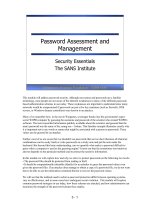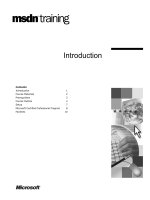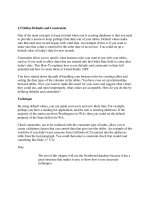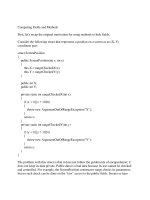Tài liệu Warranties, Patents, and Ethical Considerations Warranties and Guaranties ppt
Bạn đang xem bản rút gọn của tài liệu. Xem và tải ngay bản đầy đủ của tài liệu tại đây (203.13 KB, 5 trang )
185
6 Warranties, Patents, and
Ethical Considerations
6.1 Warranties and Guaranties
When a mold maker builds a mold, it is expected to perform as quoted and
to last without breakdowns for a long time. It is also expected to make the
product to specifications and dimensionally correct, and at a productivity
that has been estimated to the best knowledge of the designer and mold
maker.
6.1.1 Guaranteed Quality
Normally, a mold maker will guarantee the quality of the mold for six months
or for one year, covering materials and labor. In fact, if problems did not
arise within the first few weeks or months (or the first few thousand molding
cycles) after start of operation, a properly designed and built mold, well
maintained, will virtually last forever, except for unavoidable wear on tapers,
gates, etc., or when abusing the mold, e.g., by improper setup, or physical
damage due to negligence.
Occasionally, the mold maker may be asked to guarantee shrinkage, cycle
time, or delivery time.
6.1.2 Guaranteed Shrinkage
Experienced designers or mold makers can usually foresee the shrinkage,
especially if they are familiar with the product. Shrinkage affects not only
the dimensions of a product but sometimes also its shape by distorting the
product. This can be difficult to foresee, in particular with non-symmetrical
and odd-shaped products. In many cases, this requires experimentation before
finalizing the mold or testing after some or the entire mold is finished. It
could require experimenting with cycle times, even changing some steel
dimensions, or the cooling provisions in all or in certain areas of the mold.
Often, the molder will provide steel sizes to the mold maker, eliminating the
need and cost to guarantee the plastic sizes. There are also usually only one
or a few dimensions that are critical and these should be the only ones
guaranteed.
The possibility of the need to experiment to arrive at proper sizes should be
foreseen by the estimator and should be included in the mold price by
selecting a higher risk factor. As an alternative, such testing and necessary
rework could also be quoted separately as addition to the mold price, e.g., by
quoting labor and materials required to achieve the desired result.
1281han06.pmd 28.11.2005, 11:08185
186
6 Warranties, Patents, and Ethical Considerations
6.1.3 Guaranteed Cycle Time
An experienced molder, designer, or mold maker will have a good idea what
cycle time to expect. A mold quote can include the estimated, approximate
cycle times, e.g., “estimated 10–12 s cycle” (or “estimated 5–6 shots per
minute”), together with the specified physical characteristics of the mold.
Some customers (not necessarily molders) want to have the cycle time
guaranteed. It is quite risky for the mold makers to accept such a demand.
The estimated times are always given to the best of their knowledge and
experience and the mold makers will do their best to achieve the quoted
cycle time. If the customer insists on a written guarantee for a certain cycle
time, an experienced mold maker may consider accepting it, provided that
there will also be a guaranteed premium if the cycle time is better than
promised. Such an arrangement could be, for example, that the customer
will get a percentage of the mold price reduced for each second or fraction
of a second that the cycle is longer, and will pay a premium of the same
amount for every second or fraction of a second the cycle is shorter than the
guaranteed cycle, up to a certain limit.
There is always the problem that, in some cases, higher speed may affect the
quality of the product. This must be recognized before and discussed with
the molder, before agreeing to any, especially shrinkage, warranty.
6.1.4 Guaranteed Delivery
Here too, it is a question of the mold maker’s experience with the mold and
their understanding and control of the mold shop load. If the customer wants
to have the mold within a certain, reasonably short period and wants to
negotiate penalties if the mold is not ready as promised, this could be accepted
provided that the customer is also willing to pay a premium equal to the penalty
if the mold is ready before the promised delivery date.
I have seen both guaranteed cycle times and guaranteed deliveries and most
often the jobs were concluded to the mold maker’s benefit. Note that the
customers were never unhappy to pay the premium, because they too gained
by being in production sooner and/or gaining higher productivity.
6.2 Patents and Ethical Considerations
While patents and ethics may not directly or immediately affect the cost of a
mold, everyone in this chain should be aware of the risks and problems of
ignoring potential patents or unethical behavior. The following highlights
some of the basics that anybody considering a new product and/or a new
mold design should be aware of.
All guarantees must be agreed to in
writing, before the project starts
1281han06.pmd 28.11.2005, 11:08186
187
6.2 Patents and Ethical Considerations
6.2.1 Patents
Patents are issued by the patent office. They describe in detail the patented
features (“improvements”) of parts of or of whole products, or machines
(“apparatus”), or of methods of manufacturing. The features to be patented
must satisfy all three of the following. They must be
“novel”, i.e., new and “surprising” to anyone familiar with the subject,
“useful”, i.e., explain at least one useful purpose, and
“feasible”, i.e., the patent application must show at least one possible way
of how the improvements can be achieved and how they function.
“Claims” define precisely, which features are claimed to be patented. A claim
can cover a portion or a whole machine, a product or part of a product, or a
method, but most often it covers just an “improvement” of a certain (often
very small) area or feature of a product, machine, or process.
An issued patent does not protect the inventors, but gives them the right to
legally attack anybody who is “infringing”, i.e., “making”, “selling”, or “using”
anything covered by the claims.
A patent is valid (effective) only in the country where the patent was issued
and only for a limited time, usually 17 years from the day of issue. A patent,
issued in the USA, does not give the right to attack someone in other countries
from making, selling, or using it, but it gives the right to attack anyone who
wants to use or sell this infringing product in the USA.
An issued patent is an asset, and can be sold or licensed. In assessing the
value of a company, banks and investors look favorably at a company who
owns patents.
“Design patents” cover certain special shapes and patterns of (usually)
consumer items. Design patents are much easier to obtain, however, their
value is often questionable.
“Prior art”. When applying for a patent, the inventors must solemnly declare
that, to their best knowledge, they are not aware of anyone who has ever
used or published the claimed feature or design anywhere else in the world;
they must also indicate all the fields where the “invention” applies. The patent
office will then do a perfunctory search of similar features in existing patents,
not necessarily only in the indicated fields, and if none are found, can issue a
patent. This process from application to issuance can take one or more years
and is quite expensive, especially because a patent attorney should handle it
to comply with the proper format and wording of the application. There are
no patent rights while the application is being considered, but there are some
advantages for the inventor between the date of application and the date of
issue of the patent.
Prior art is the weak spot of most patents. If it can be proven that the “claimed”
features have been used anywhere in the world, whether patented or not,
“A patent is a Sword, not a Shield”
1281han06.pmd 28.11.2005, 11:08187
188
6 Warranties, Patents, and Ethical Considerations
prior to the date of the application, even an issued patent can be declared
invalid. A worldwide search can be very expensive. It covers only issued patents
in some countries, some trade magazines, articles or books, but not all
magazines nor all published catalogues, or designs or practices which are or
were in public use. For most patents that have been declared invalid it was
discovered after issue that the claims were not “novel”.
If an inventor decides not to apply for a patent, he or she can select to publish
the product in which the invention is clearly used, e.g., in a sales catalogue,
advertisements, or trade magazine. While thereby forgoing any right for a
patent, it also prevents anyone else to get a patent after the date of publishing.
It is often a question of simple economics to decide whether it is worthwhile
to apply for a patent.
A patent is only of value to the owner as long as anyone infringing it is found
out by the owner of the patent, first warned to “cease and desist” and
eventually, if needed, prosecuted. These legal proceedings are very expensive
and can draw out over years. It is often better and much cheaper to settle
such disputes amicably.
Also, if the owner of a patent does not use a patent within a stipulated time
after issue (typically 5 years), or does not prosecute a known “infringer”, the
patent can become invalid.
If a product is wholly or partly covered by one or more patents, the relevant
patent number(s) must be disclosed, either on the product itself by engraving,
printing, or on an attached nameplate. If the product is too small, or if, for
other reasons, it is impractical to show the number(s) on the product itself,
they can be shown on the packaging for the product. The frequently found
words such as “patent protected”, “patent issued”, “patent pending”, or any
abbreviation thereof have no value. The country granting the patent should
also be shown, e.g., “US pat. #9,876,543”.
The patent numbers put the buyer or user of the product on notice that
there are patented features to consider which may be used to prevent any
copier from proceeding. But on the other hand it also opens the door to an
attack by a copier to declare the patent(s) invalid because of possible prior
art that has not been found during the original patent application.
How Do Patents Affect the Decision Maker and the Mold Maker?
Both parties should be aware that any patents they do not own or are licensed
to use could be used to prosecute either the customer, the molder, the mold
maker, or even the end user of the product, or any or all of them. Anyone
making, selling, or using a product (and that includes the mold) that is covered
by a patent is subject to prosecution by the rightful owner of the patent.
Anyone who wants to have a mold built for any product must be asked to
assure the molder and the mold maker in writing that, to their knowledge,
there is no valid patent covering all or some of the features of the product for
which a mold needs to be built and also agree (in writing) that they will
The most frequent reason for
declaring a patent invalid is that
“prior art” has been unearthed
1281han06.pmd 28.11.2005, 11:08188
189
assume full responsibility to keep the other involved parties harmless in the
event of prosecution because of patent infringement (“hold-harmless
agreement”).
A similar agreement may be necessary between the mold maker and the
molder that the mold does not contain any patented features which could be
attacked by an owner of a valid patent. This could happen to the molder or
even the end user after the product is sold to the public. Typically, this applies
when copying patented mold features, such as hot runner hardware, ejection
and handling methods, and others.
When finalizing a purchasing contract for a new mold or molding system, it
is good practice to discuss the ownership of any patentable features that may
be the result of designing the molds or ancillary equipment by the mold
designer or the mold maker. There could be an agreement that any issuing
patent(s) will be owned by the purchaser (customer) of the mold, who will
also assume the costs of obtaining the patent, but naming the actual designer
or designers as inventors, and maybe including the names of the product
designers of the customer. It could also stipulate that the mold maker will
have the right to use such patentable features in other molds, but not in
molds that would compete with the patent owner.
6.2.2 Ethical Considerations
Not all copying problems apply to patented features only. For example, let’s
assume a new, but not patented, plastic product is launched by an entre-
preneur and turns out to be a great success. The mold maker, who built the
original mold, will probably be asked to work on additional, better molds
with more output, to cover the expected increased demand. At this moment,
some other entrepreneur may see an opportunity to make and sell the same
or a very similar product and approach the same mold maker to build a
similar mold for this competing entrepreneur. Often, such “copiers” don’t
even bother with a product drawing but just bring a sample of the original
product, from which the mold maker should build a mold. In this case, the
problem could be solved simply by the mold maker, by flatly refusing to get
involved. It would be neither ethical, nor fair to their existing customer to
help a competitor.
Another frequent scenario is a prospective customer, or a molder, presenting
the mold maker with a sample of a product made by someone else and the
mold maker was not originally involved with it. In such cases, it is better to
ask the customers to come back for quotations when they have their own
completely detailed, toleranced, and dimensioned drawing ready, complete
with assurances as indicated above regarding patent infringement.
Under those conditions a job can be accepted.
6.2 Patents and Ethical Considerations
1281han06.pmd 28.11.2005, 11:08189









